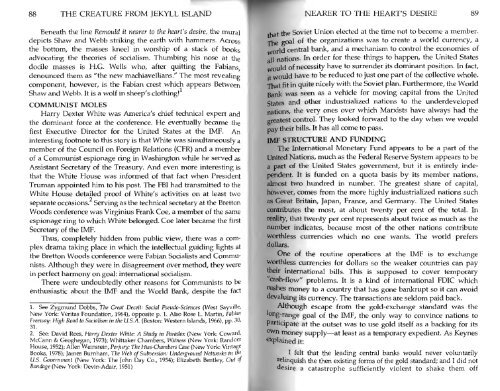Create successful ePaper yourself
Turn your PDF publications into a flip-book with our unique Google optimized e-Paper software.
88 THE CREATURE FROM JEKYLL ISLAND<br />
•"<br />
NEARER TO THE HEART'S DESIRE 89<br />
Beneath the line Remould it nearer to the heart's desire, the mural<br />
depicts Shaw and Webb striking the earth with hammers. Across<br />
the bottom, the masses kneel in worship of a stack of books<br />
advocating the theories of socialism. Thumbing his nose at the<br />
docile masses is H.G. Wells who, after quitting the Fabians,<br />
denounced them as "the new machiavellians." The most revealing<br />
component, however, is the Fabian crest which appears Between<br />
Shaw and Webb. It is a wolf in sheep's clothing!<br />
COMMUNIST MOLES<br />
Harry Dexter White was America's chief technical expert and<br />
the dominant force at the conference. He eventually became the<br />
first Executive Director for the United States at the IMF. An<br />
interesting footnote to this story is that White was simultaneously a<br />
member of the Council on Foreign Relations (CFR) and a member<br />
of a Communist espionage ring in Washington while he served as<br />
Assistant Secretary of the Treasury. And even more interesting is<br />
that the White House was informed of that fact when President<br />
Truman appointed him to his post. The FBI had transmitted to the<br />
White House detailed proof of White's activities on at least two<br />
separate occasions.<br />
Serving as the technical secretary at the Bretton<br />
Woods conference was Virginius Frank Coe, a member of the same<br />
espionage ring to which White belonged. Coe later became the first<br />
Secretary of the IMF.<br />
Thus, completely hidden from public view, there was a complex<br />
drama taking place in which the intellectual guiding lights at<br />
the Bretton Woods conference were Fabian Socialists and Communists.<br />
Although they were in disagreement over method, they were<br />
in perfect harmony on goal: international socialism.<br />
There were undoubtedly other reasons for Communists to be<br />
enthusiastic about the IMF and the World Bank, despite the fact<br />
1. See Zygmund Dobbs, The Great Deceit: Social Pseudo-Sciences (West SayviNe,<br />
New York: Veritas Foundation, 1964), opposite p. 1. Also Rose L. Martin, Fabian<br />
Freeway: High Road to Socialism in the U.S.A. (Boston: Western Islands, 1966), pp. 30,<br />
31.<br />
2. See: David Rees, Harry Dexter White: A Study in Paradox (New York: Coward,<br />
McCann & Geoghegan, 1973); Whittaker Chambers, Witness (New York: Random<br />
House, 1952); Allen Weinstein, Perjury: The Hiss-Chambers Case (New York: Vintage<br />
Books, 1978); James Burnham, TJie Web of Subversion: Underground Networks in the<br />
US. Government (New York: The John Day Co., 1954); Elizabeth Bentley, Out of<br />
Bondage (New York: Devin-Adair, 1951)<br />
that the Soviet Union elected at the time not to become a member.<br />
The goal of the organizations was to create a world currency, a<br />
world central bank, and a mechanism to control the economies of<br />
all<br />
nations. In order for these things to happen, the United States<br />
would of necessity have to surrender its dominant position. In fact,<br />
it would have to be reduced to just one part of the collective whole.<br />
FXhat fit in quite nicely with the Soviet plan. Furthermore, the World<br />
Bank was seen as a vehicle for moving capital from the United<br />
States and other industrialized nations to the underdeveloped<br />
1<br />
nations, the very ones over which Marxists have always had the<br />
greatest control. They looked forward to the day when we would<br />
pay their bills. It has all come to pass.<br />
IMF STRUCTURE AND FUNDING<br />
The International Monetary Fund appears to be a part of the<br />
United Nations, much as the Federal Reserve System appears to be<br />
a part of the United States government, but it is entirely independent.<br />
It is funded on a quota basis by its member nations,<br />
almost two hundred in number. The greatest share of capital,<br />
however, comes from the more highly industrialized nations such<br />
as Great Britain, Japan, France, and Germany, The United States<br />
contributes the most, at about twenty per cent of the total. In<br />
reality, that twenty per cent represents about twice as much as the<br />
number indicates, because most of the other nations contribute<br />
worthless currencies which no one wants. The world prefers<br />
dollars.<br />
One of the routine operations at the IMF is to exchange<br />
worthless currencies for dollars so the weaker countries can pay<br />
their international bills. This is supposed to cover temporary<br />
"cash-flow" problems. It is a kind of international FDIC which<br />
rushes money to a country that has gone bankrupt so it can avoid<br />
devaluing its currency. The transactions are seldom paid back.<br />
Although escape from the gold-exchange standard was the<br />
lor >g-range goal of the IMF, the only way to convince nations to<br />
Participate at the outset was to use gold itself as a backing for its<br />
own money supply—at least as a temporary expedient. As Keynes<br />
explained it:<br />
I felt that the leading central banks would never voluntarily<br />
relinquish the then existing forms of the gold standard; and I did not<br />
desire a catastrophe sufficiently violent to shake them off


